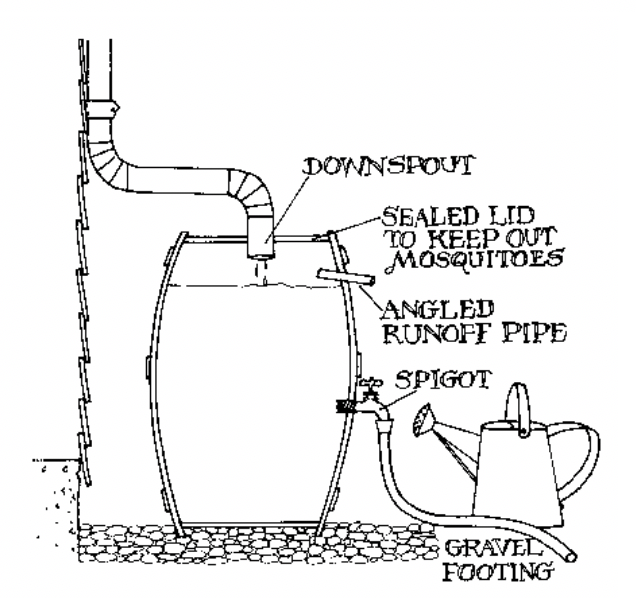Rain Barrels and Cisterns
New ResidentialWhat are Rain Barrels?
Rain barrels collect, store, and distribute water for later use, providing a cost-effective and environmentally beneficial way to conserve water and minimize problems associated with stormwater runoff. Use rainwater collected in barrels from catchment areas such as rooftops for irrigation, flushing toilets and other non-potable uses (see On-site Alternative Water Reuse). Treat or filter the water depending on the intended use.
Standard components of a rain harvesting system include[1]
- Catchment area such as a roof
- Gutters and downspouts
- Leaf screens
- Rain barrel for storage
- Conveyance system to deliver stored water via gravity or pump
- Water treatment or filter system

Figure 1-Simple schematic design for rain barrels (Source: Low Impact Development Center)
How to Incorporate Rain Barrels
Set aside sufficient space, either interior, above ground or underground, for the appropriately sized barrel. Residential rain barrels can range in size but typically hold 55-gallons. To calculate the volume of water available for capture, assume that every 1,000 square feet of catchment area generates 600 gallons of runoff during a one-inch rainfall event.[2]

Consider combining rain barrels with a drip irrigation system to direct overflow to a dry well, rain garden or bio-retention area.
Rain barrels require maintenance. Use water within two weeks to prevent algae growth and clean barrels every few months. A screen with a cover prevents algae growth and mosquito breeding. Drain, disconnect and store rain barrels during the winter months.
For more detailed information about the design and construction of rain barrels see the Rutgers Water Resources Program’s – Green Infrastructure Manual for New Jersey.
Example
Residential Rain Barrel, Lakehurst, NJ
Part of the Rutgers Sustainable Landscape Demonstration Site Program, the Lakehurst residential renovation project included a 35-gallon rain-barrel or repurposed trash can to collect and redirect water to an adjacent ornamental flower bed, eliminating the need for on-site irrigation and municipal water use.
Benefits
- Reduces demand for potable water for irrigation and other non-potable uses (see Water-Efficient Landscape Design).
- Lowers peak demand and peak discharge rate on public water systems.
- Reduces overall potable water use and saves money on water bills.
- Reduces stormwater runoff via storage (see Emergency Water Supply and Storage).
- Reduces runoff of contaminants into soils and waterways.
Costs
Costs vary depending on the size and type of rain barrel selected. Small-scale systems cost around $60 for a 55-gallon barrel.[3] Some watershed associations or municipalities offer rain barrels at a discount or provide rebates.
Resiliency
Water stored in rain barrel can provide an alternative water source for non-potable uses during storms, hurricanes and droughts or when municipal water sources are shut down or become polluted. Filter and purify before using the water to irrigate edible gardens, wash dishes, or provide water for drinking and showering. Rain barrels also help mitigate flooding by capturing water that would end up in the municipal water system.
[1] US DOE | EERE. “Best Management Practices: Alternate Water Sources.” https://www.energy.gov/eere/femp/best-management-practice-14-alternative-water-sources (accessed April 2, 2018).
[2] Rutgers Water Resources Program. Green Infrastructure Manual for NJ. http://water.rutgers.edu/Green_Infrastructure_Guidance_Manual/2015-03-31_Manual.compressed.pdf (accessed April 3, 2018).
[3] Massachusetts Metropolitan Area Planning Council. “Low Impact Development Toolkit – Fact Sheet: Cisterns and Rain Barrels.” http://www.mapc.org/wp-content/uploads/2017/11/LID_toolkit_factsheets_7-9.pdf (accessed March 25, 2018).
Resources
- NJ DEP
- US EPA
- Rutgers Cooperative Extension
- Water Resources Group
- Rutgers Water Resources Program
- Rain Barrels Part I: How to Build a Rain Barrel
- Rain Barrels Part II: Installation and Use
- Rain Barrels Part III: Building a Rain Barrel from a Plastic Trash Can
- Fact Sheet, Where to Get Your Drinking Water Tested in New Jersey: A List of State Certified Water Testing Laboratories by County
- Rutgers Rain Barrel Train the Trainer Program
- Landscape for Life
- The Sustainable Sites Initiative
